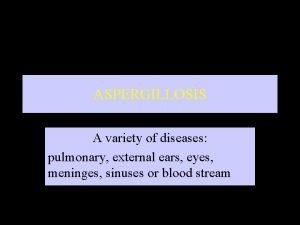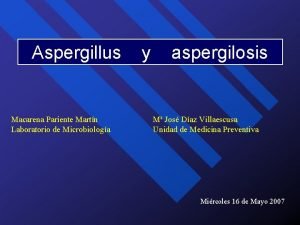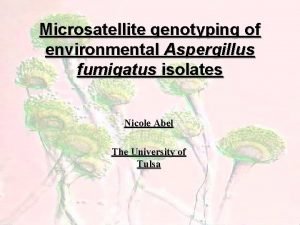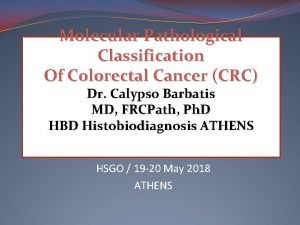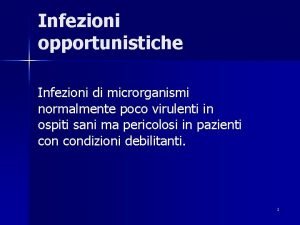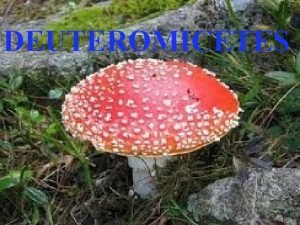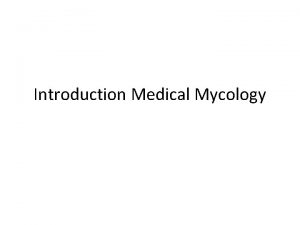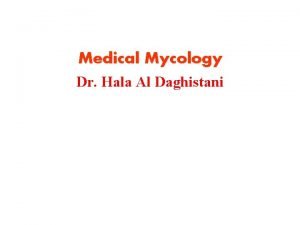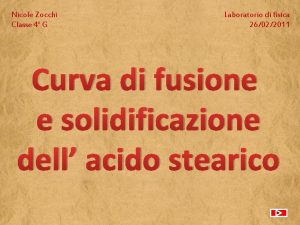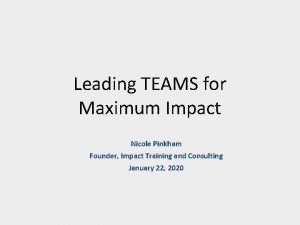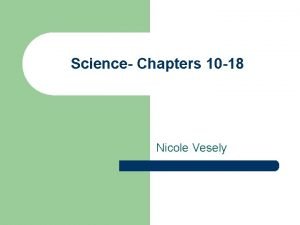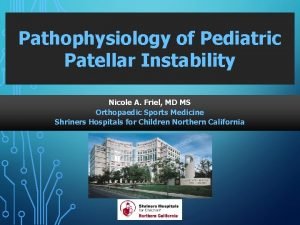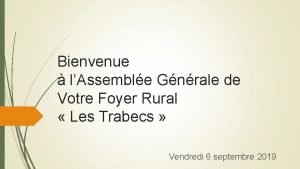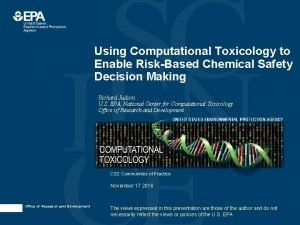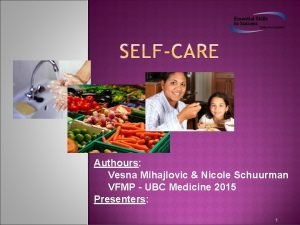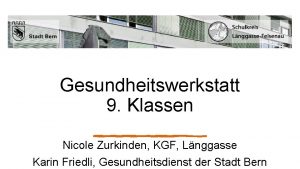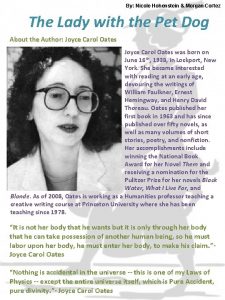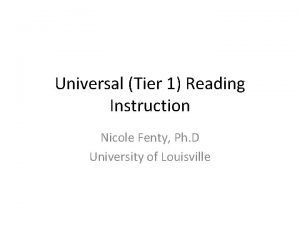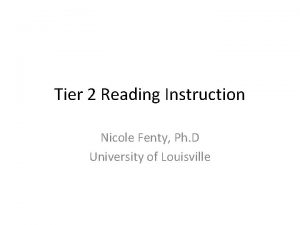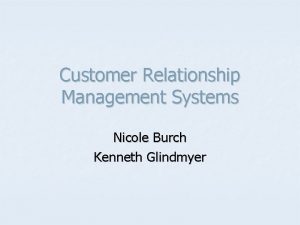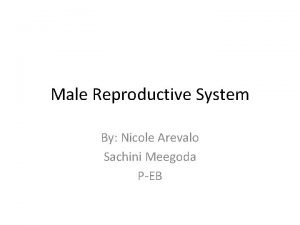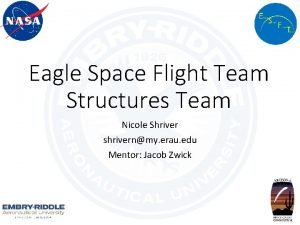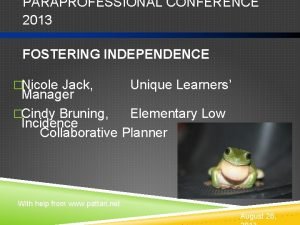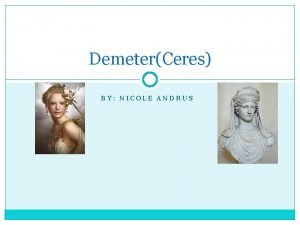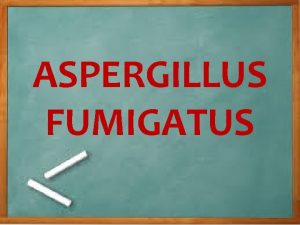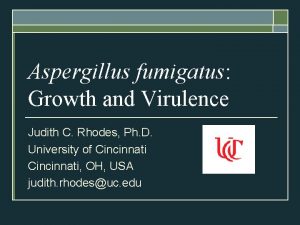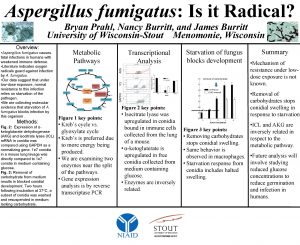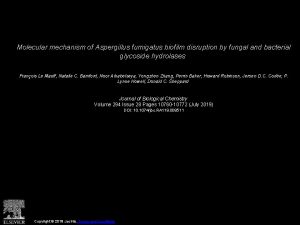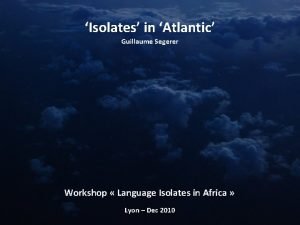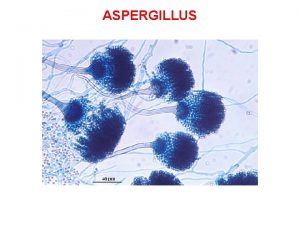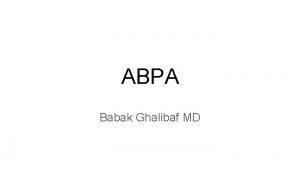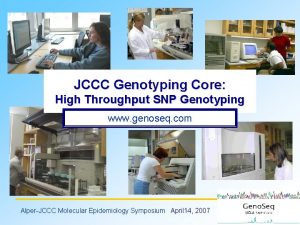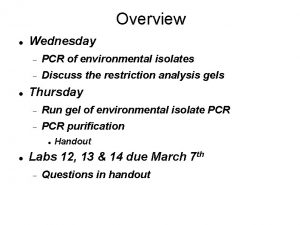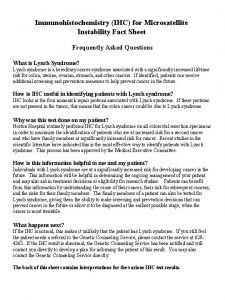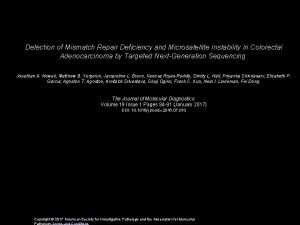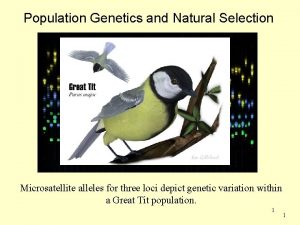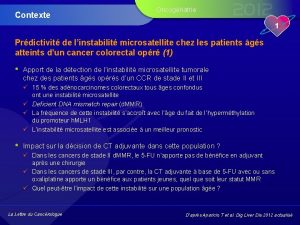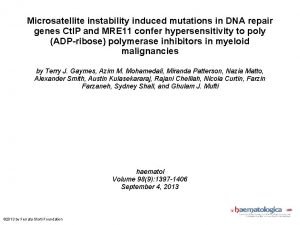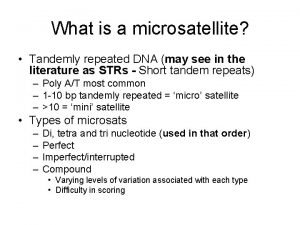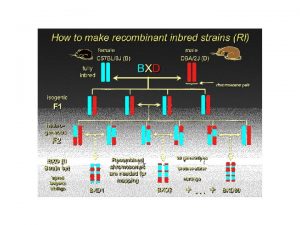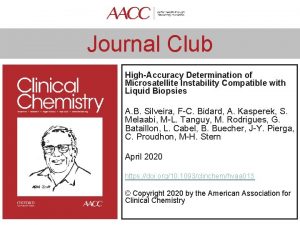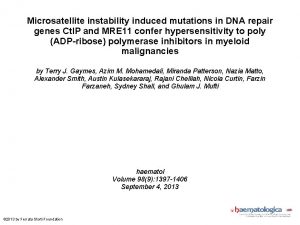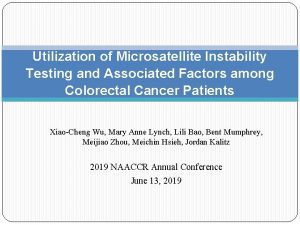Microsatellite genotyping of environmental Aspergillus fumigatus isolates Nicole




















































- Slides: 52

Microsatellite genotyping of environmental Aspergillus fumigatus isolates Nicole Abel The University of Tulsa

Introduction • J&M FARMS – Miami, OK (Ottawa Co. ) – Large outdoor compost facility – Commercial mushroom farm – Complaints about smell and perceived health effects

Concerning Statistics • 13. 4% of Ottawa County residents have asthma • Average asthma rate for rest of OK is 7. 2%

Compost & Bioaerosols • Several microorganisms break down the organic matter in compost to create a usable product • During composting process, compost is churned mechanically • Mechanical agitation cause these biological agents to become aerosolized – “bioaerosol” • Increasing concern about the potential impact of composting on human health

Aspergillus fumigatus • Fungus of the genus Aspergillus • Dominant bioaerosol from compost • Most common species in this genus to cause disease in individuals with a compromised immune system

Aspergillus fumigatus

Aspergillus fumigatus • Bioaerosol health concerns are focused on Aspergillus fumigatus for several reasons: – Grows abundantly in compost – Can survive at peak compost temperatures – Can survive temperature of the human body – Conidia are easily airborne – When inhaled, small enough to reach lung – Several well-known health effects

Health effects of AF • AF is known to cause a wide span of invasive diseases collectively called “Aspergillosis” • Traditionally viewed as weak pathogen, causing problems with asthma, allergies, and other diseases: – “Farmer’s lung” – Aspergilloma – Fungal sinusitis

Health effects of AF – “Farmer’s lung” • Inflammation of the lungs due to repeated exposure to the spores • Symptoms of acute farmer’s lung: – Chills, Cough, Fever, Shortness of breath • Symptoms of chronic farmers lung: – Breathlessness, Cough, Loss of appetite, weight loss • Often reverseable by avoiding additional exposure • Chronic form may lead to scarring of lung tissue

Health effects of AF – Aspergilloma • an overgrowth of the fungus on the surface of preexisting cavities in the lungs • This often occurs in patients treated successfully for tuberculosis • Often no symptoms, but most common symptom is coughing up blood (hemoptysis) • Most cases do not require treatment • With severe hemoptysis, surgery may be required to remove the aspergilloma and stop the bleeding

Health effects of AF – Fungal sinusitis • Inflammation of sinuses • Patients often have allergies or asthma • Thick fungal debris and sticky mucus that must be surgically removed in order to keep the inflammatory condition under control • At times this massive nasal polyposis and fungal debris can expand erode towards the eyes or brain.

Health effects of AF • The situation has become much more serious in recent years – increase in the number of immunosuppressed patients – degree of severity of modern immunosuppressive therapies, • Now most common airborne pathogenic fungus • Causes wide span of severe and usually fatal invasive infections in the immunocompromised

Aspergillosis • Extrinsic asthma- most common, occurs in allergic individuals, causes cough, wheezing, chills, aches, and pains • Extrinsic allergic alveolitis- can occur in those without allergies, but with repeated exposure to AF spores and many of the spores reach lung tissue, causes coughing, difficulty in breathing, and fever • Allergic bronchiopulminary aspergillosis- more serious form of “Farmer’s lung”, may follow entrinsic asthma, but symptoms are chronic and more severe, treatment is required or this disease can be fatal

Aspergillosis • Invasive Aspergillosis – – – Most dangerous and rare Occurs in the immunocompromised AF grows from the lung into other organs Often fatal Causes 30% of fungal infections in cancer patients Occurs in 10 -25% of patients being treated for leukemia. Even treated, the mortality rate for these patients is 8090% – Major cause of death at transplant and leukemia centers


Peoria Tribe/University of Tulsa Air Quality Studies in Miami, OK

Phase 1 • Previous study recorded elevated airborne A. fumigatus within 400 m of compost facility • A. fumigatus spores were significantly higher downwind of compost facility than control sites • Problem: Air samples not done in populated areas so not pertinant to public health

Present Study 2009 -2010 • Objectives: – Determine AF conc. in facility’s compost – Determine airborne AF conc. in Ottawa Co. vs. Tulsa Co. – Determine genetic relation between airborne AF in Ottawa Co. , AF in the facilty’s compost, and if distinct from Tulsa AF controls

Hypothesis • AF concentrations in facility’s compost will be high • Airborne AF concentration will be greater in Ottawa Co. vs. Tulsa Co. • AF from compost & Ottawa Co. air will be genetically identical • AF from Tulsa air will be genetically different from AF from Ottawa Co. air and compost isolates

Compost Windrows Miami, OK

Compost • Purchased 6 truckloads of spent compost from facility • 1 gallon bag from each truckload was brought to our lab at TU • 10 random samples obtained from each bag of compost • Samples dilution plated onto MEA containing Streptomycin in dilutions of 10 -1, 10 -2, and 10 -3 • Plated AF concentrations in the compost ranged from 0 -100, 000 CFU/g

Compost 1 Sample 2 10 -1 10 -2 840 CFU/g 10 -3

Compost 1 Sample 1 10 -2 100, 000 CFU/g 10 -3


Air Samples • Ottawa Co. - samples collected from 5 locations within 5 miles of facility (selected by the EPA) • Tulsa Co. - samples collected from 5 random locations in Tulsa (144 km upwind from compost site) to serve as control • Verified control sites do not use compost from this facility • Sampling done once a week with Anderson Single Stage Samplers onto MEA plus streptomycin plates for a total of 39 weeks

Ottawa Co. Air Sample Locations Commerce Picher North Miami Quapaw Miami Compost Facility/ Mushroom farm

Tulsa Air Sample Locations Kendall. Whittier Mohawk Park Woodward Park University of Tulsa campus Lakewood Gardens

Average AF for Each Sample Location -------Ottawa Co. -------Tulsa Co. -------

Average Airborne AF each Month Ottawa Co. vs. Tulsa Co. Number of times AF collected from air in 39 weeks: Ottawa Co. - 17 Tulsa Co. -8

Overall Average Airborne AF CFU/m 3 Ottawa Co. vs. Tulsa Co. P=0. 0238 (Statistically Significant)

Mushroom Side Project • Several samples of the compost had extremely high levels of AF • Commercial mushrooms are grown in the compost • Could their mushrooms have elevated AF on their surface when sold in grocery store?

Mushrooms • Purchased 7 brands of mushrooms (including J&M) • Compost from each brand was removed from surface of mushrooms • Samples diluted to 10 -1, 10 -2, and 10 -3 onto MEA plates with Streptomycin and incubated • AF colonies were identified and counted

J&M Grocery Mushrooms


Mushroom Side project #2 • J&M mushrooms have excessive AF on their surface • AF is hydrophobic and becomes airborne easily • If these mushrooms are washed in a sink, will they become airborne in the kitchen?

Mushroom Washing • J&M mushrooms were purchased and washed in a sink to mimic home use • Air samples collected next to the sink using an Anderson single stage sampler with MEA plates before, during, and after washing • This process was repeated with separate packages of mushrooms for a total of three trials

Airborne AF During Mushroom Washing

Subcultures • All plates from air samples, compost, and mushrooms were incubated at 45° C for 48 hours • All AF isolates were sub-cultured & grown in malt extract broth

Microsatellite • A microsatellite is a specific sequence of DNA bases which are repeated a certain # of times. For example: – GTGTGT---’GT’ X 6 – CTGCTG---’CTG’ X 4 – ACTCACTC---’ACTC’ X 4 • Microsastellites can differ in # of repeats & are hereditary, so # of repeats can determine relatedness • AKA – simple sequence repeats (SSR) – short tandem repeats (STR) – variable number tandem repeats (VNTR)

Microsatellite Applications • Forensics – Link a suspect with a sample of blood, semen or hair taken from a crime – Link a sample found on a suspect's clothing with a victim – Investigating paternity in order to establish rape or incest – Linking DNA samples with relatives of a missing person

Microsatellite Applications – Diagnosis & identification of human diseases • Change in length early in development of some cancers • Early cancer detection • Polymorphic, so useful in locating genes responsible for various genetic disorders

Microsatellite Applications – Population studies • Variation of microsatellites in populations can help to make inferences about pop. – Structures – Differences – Genetic drift – Genetic bottlenecks – Date of a last common ancestor

Microsatellite Applications • Conservation biology • Detect sudden change in population, • Effects of population fragmentation • Interaction of different populations • Identification of new and incipient populations.

DNA extraction • The DNA was extracted from all isolates using EZNA kit • DNA concentrations extracted from each isolate were documented using the Nanodrop 8000

Identification and PCR • Isolates positively identified as AF using: – Microscopic analysis – DNA analysis of ITS gene • DNA extraction • PCR • Sequencing

Genotyping • 9 microsatellites were used to discriminate between the isolates of AF using the method of de Valk et al. (2005) – Genotyped using complete panel of 9 microsatellites (ABI 3130 xl Capillary Sequencer) – Genotypes analyzed – Strains and relatedness determined (Gene. Mapper v 4. 0)

AF STRAINS

Conclusions Compost • Aspergillus fumigatus concentration in J&M’s compost was extremely variable (0100, 000 CFU/g) • Bags #1 & #2 contains extremely high amounts of AF • Some J&M compost contains very high levels of AF and is mechanically agitated, it is possible this could cause elevated airborne AF in the surrounding area.

Conclusions Air Samples • Total airborne spore concentration significantly higher in Ottawa Co. vs. Tulsa Co. • P=0. 0238 • The sampling location with highest airborne conc. Is most often downwind from J&M

Conclusions Genetic Analysis • Genetic variation exists amongst the isolates; however: – 3 of 3 isolates from mushrooms match compost – 2 of 2 Isolates from air sampling during mushroom washing match compost – 12 of 19 isolates from Ottawa Co. air match compost – 30 of 48 isolates from compost match Ottawa Co. air samples – Tulsa isolates distinct from all J&M isolates

Acknowledgments • • • Dr. Estelle Levetin Dr. Mark Buchheim Dr. Ron Bonett Jacob Crowley Justin Downs and Brandon Bartley Funding for this study was provided by the Peoria Tribe of Indians through an • EPA grant

Thank you! Questions?
 Aspergillus fumigatus
Aspergillus fumigatus Spergillus
Spergillus Aspergillus
Aspergillus Aspergillus
Aspergillus Microsatellite instability
Microsatellite instability Microsatellite instability
Microsatellite instability Metule
Metule Reino fungi deuteromicetos
Reino fungi deuteromicetos Capsulated fungi examples
Capsulated fungi examples Medical
Medical Wireless health
Wireless health Natalia castillejo duolingo
Natalia castillejo duolingo Nicole schimmel
Nicole schimmel Nicole sirbu
Nicole sirbu Historia de damaris nicole
Historia de damaris nicole Nicole hruban
Nicole hruban Nicole
Nicole Nicole pinkham
Nicole pinkham Nicole vesely
Nicole vesely Nicole noel purdue
Nicole noel purdue Nicole friel
Nicole friel Nicole ong
Nicole ong Nicole brust
Nicole brust Nicole engdahl
Nicole engdahl Nicole gallina
Nicole gallina Nicole kleinstreuer
Nicole kleinstreuer Vesna mihajlovic
Vesna mihajlovic Nicole val
Nicole val Nicole zurkinden
Nicole zurkinden Hgamepass
Hgamepass Morgan cortez
Morgan cortez Nicole alexander md
Nicole alexander md Nicole fenty
Nicole fenty Nicole nieto osu
Nicole nieto osu Nicole fenty
Nicole fenty Nicole charest
Nicole charest Nicole rime
Nicole rime Nicole charest
Nicole charest Alana green
Alana green Nicole rivi
Nicole rivi Nicole salem
Nicole salem Nicole latulippe
Nicole latulippe Nicole burch
Nicole burch Nicole arevalo
Nicole arevalo Zzfake
Zzfake Jedec standard
Jedec standard Oj simpson bruno magli shoes photo
Oj simpson bruno magli shoes photo Scapulohumeraal ritme
Scapulohumeraal ritme Nicole shriver
Nicole shriver Nicole richelle
Nicole richelle Nicole
Nicole Nicole
Nicole Demetersgarden
Demetersgarden
